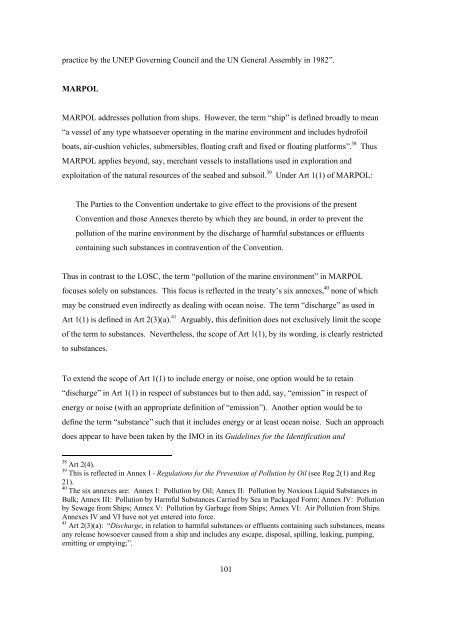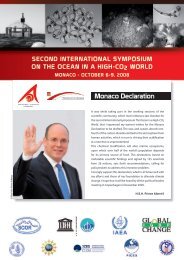Oceans of noise - Whale and Dolphin Conservation Society
Oceans of noise - Whale and Dolphin Conservation Society
Oceans of noise - Whale and Dolphin Conservation Society
- No tags were found...
Create successful ePaper yourself
Turn your PDF publications into a flip-book with our unique Google optimized e-Paper software.
practice by the UNEP Governing Council <strong>and</strong> the UN General Assembly in 1982”.MARPOLMARPOL addresses pollution from ships. However, the term “ship” is defined broadly to mean“a vessel <strong>of</strong> any type whatsoever operating in the marine environment <strong>and</strong> includes hydr<strong>of</strong>oilboats, air-cushion vehicles, submersibles, floating craft <strong>and</strong> fixed or floating platforms”. 38 ThusMARPOL applies beyond, say, merchant vessels to installations used in exploration <strong>and</strong>exploitation <strong>of</strong> the natural resources <strong>of</strong> the seabed <strong>and</strong> subsoil. 39 Under Art 1(1) <strong>of</strong> MARPOL:The Parties to the Convention undertake to give effect to the provisions <strong>of</strong> the presentConvention <strong>and</strong> those Annexes thereto by which they are bound, in order to prevent thepollution <strong>of</strong> the marine environment by the discharge <strong>of</strong> harmful substances or effluentscontaining such substances in contravention <strong>of</strong> the Convention.Thus in contrast to the LOSC, the term “pollution <strong>of</strong> the marine environment” in MARPOLfocuses solely on substances. This focus is reflected in the treaty’s six annexes, 40 none <strong>of</strong> whichmay be construed even indirectly as dealing with ocean <strong>noise</strong>. The term “discharge” as used inArt 1(1) is defined in Art 2(3)(a). 41 Arguably, this definition does not exclusively limit the scope<strong>of</strong> the term to substances. Nevertheless, the scope <strong>of</strong> Art 1(1), by its wording, is clearly restrictedto substances.To extend the scope <strong>of</strong> Art 1(1) to include energy or <strong>noise</strong>, one option would be to retain“discharge” in Art 1(1) in respect <strong>of</strong> substances but to then add, say, “emission” in respect <strong>of</strong>energy or <strong>noise</strong> (with an appropriate definition <strong>of</strong> “emission”). Another option would be todefine the term “substance” such that it includes energy or at least ocean <strong>noise</strong>. Such an approachdoes appear to have been taken by the IMO in its Guidelines for the Identification <strong>and</strong>38 Art 2(4).39 This is reflected in Annex I - Regulations for the Prevention <strong>of</strong> Pollution by Oil (see Reg 2(1) <strong>and</strong> Reg21).40 The six annexes are: Annex I: Pollution by Oil; Annex II: Pollution by Noxious Liquid Substances inBulk; Annex III: Pollution by Harmful Substances Carried by Sea in Packaged Form; Annex IV: Pollutionby Sewage from Ships; Annex V: Pollution by Garbage from Ships; Annex VI: Air Pollution from Ships.Annexes IV <strong>and</strong> VI have not yet entered into force.41 Art 2(3)(a): “Discharge, in relation to harmful substances or effluents containing such substances, meansany release howsoever caused from a ship <strong>and</strong> includes any escape, disposal, spilling, leaking, pumping,emitting or emptying;”.101




